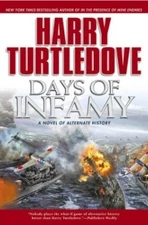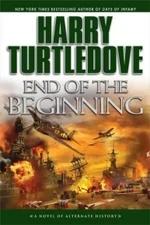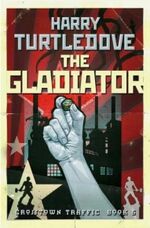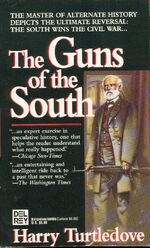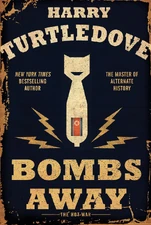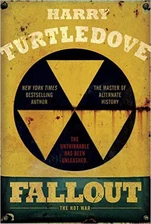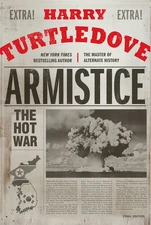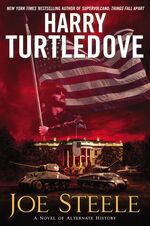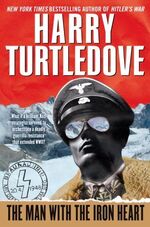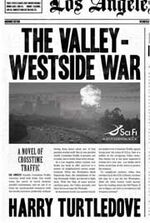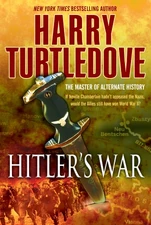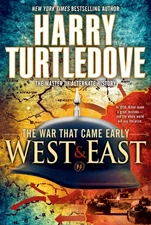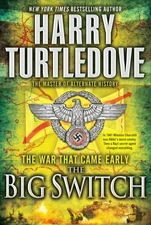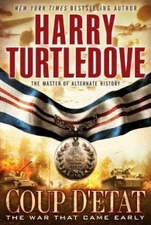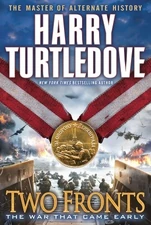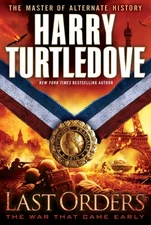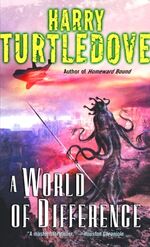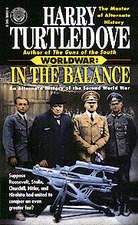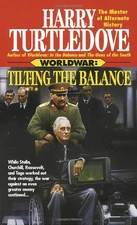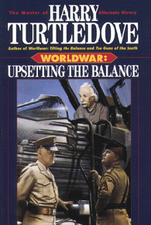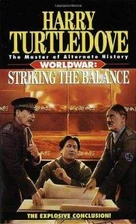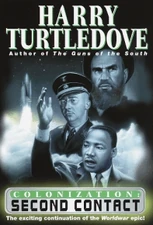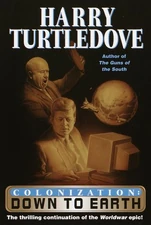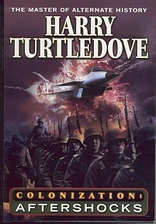| Union of Soviet Socialist Republics | |

| |
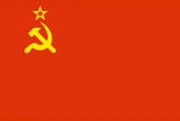
| |
| Country | |
| Continent: | Europe/Asia |
| Capital: | Moscow |
| National Language: | Russian (minority languages abounded but were officially discouraged) |
| Government: | Federal Marxist–Leninist one-party socialist state |
| Status in OTL: | Inactive |
The Soviet Union (Union of Soviet Socialist Republics [USSR], in Russian Сою́з Сове́тских Социалисти́ческих Респу́блик [CCCP]) was a communist nation stretching from Eastern Europe to the east coast of North Asia. It was founded by Vladimir Lenin in 1922 and formally dissolved into 17 separate nations by Mikhail Gorbachev in 1991.
The Soviet Union came into being in the aftermath of World War I, which proved devestating to Russia. With morale at a low ebb, and with the blame focused on Tsar Nicholas II, the country collapsed, and the Tsar was forced to abdicate in 1917. The Bolsheviks, adherents of the philosophy of Karl Marx, saw their opportunity to wrest control of the country. After a period of revolution and civil war, the Bolsheviks took power and formed the world's first communist state. Though the Soviets, as Russia's successor state, had been forced to sign the severe Treaty of Brest-Litovsk to extricate themselves from war with Germany, the USSR spent the 1920s and '30s pursuing various aggressive policies against states which had attempted to secede from Russia when the Revolution began, and the country's borders soon incorporated much of the old Russian Empire's.
In 1939, the Soviets publicly signed a non-aggression pact with Nazi Germany, though in all likelihood neither Hitler nor Stalin ever took seriously their obligations not to attack one another if a sufficiently advantageous situation arose. At the same time they signed this pact, they reached a second, secret agreement to cooperate in the conquest of Poland. Then, while World War II raged in Western and Central Europe, the USSR relatively quietly waged a series of wars against Lithuania, Estonia, Latvia, Finland, and Japan.
In 1941 Germany violated the non-aggression pact and drew the Soviet Union into World War II. For the duration of the war, the USSR was the most important member of the Allied Forces. At the cost of tens of millions of casualties, they took the lead in the Allied conquest of Germany, and extended the western border of their sphere of influence all the way to the Elbe River. They emerged from the war with their own sovereign territory expanded to the largest dimensions in Russian history, with vassal governments in most Eastern European states, and with extended influence in East Asia, including the northern half of the Korean peninsula, and in world diplomatic affairs.
From 1945 to 1991, the USSR was locked in a Cold War with the world's other superpower, the United States. Their conflict became systemic and found many expressions, including diplomatic disputes, economic warfare, endless proxy wars throughout Europe, the Middle East, Asia, Africa, and Latin America, and a nuclear arms race that prevented the two from being able to fight a war directly.
The two sides remained pretty evenly matched throughout the second half of the twentieth century, with circumstances favoring now the one, now the other. But in the 1980s, the USSR suffered, in short succession, a humiliating military defeat in Afghanistan, restlessness and nationalism within many of its vassal states, domestic turmoil around political and economic reform, and an ever-widening economic gap with the far more efficient American bloc. On 25 December 1991, Boris Yeltsin, now claiming the title of President of the Russian Federation, informed the United Nations that the USSR was defunct. The next day, General Secretary Gorbachev verified his claim and formally dissolved the Soviet Union into 17 successor states. The Cold War was over, and with it, Soviet history.
Soviet Union in "Black Tulip"
The Soviet Union intervened in Afghanistan's affairs in the 1980s. It was a costly move, as the Red Army suffered heavy casualties in various battles, of which the oddest was the Battle of Bulola whose outcome was determined by a most unusual combatant.
Soviet Union in Crosstime Traffic
The Soviet Union was long gone by the time that the secret of Crosstime was discovered in the home timeline. However, it did continue to exist in other alternates.
In an alternate where nuclear weapons had never been developed, the Soviet Union and the United States fought World War VI in the 2090s. Footage taken in this alternate was shown to Jeremy Solters and his fellow students in US history class.[1] Conversely, there were several alternates where an atomic war took place in the 20th Century. Explorers from the home timeline found that in some of these alternates the USSR had started the war whereas in others, the US had fired the first shots.[2] Some of these were in the process of getting back on their feet. Others were completely devoid of human life.
Soviet Union in The Gladiator
In one alternate visited by Crosstime Traffic, the Soviet Union won the Cold War after the United States backed down during the Cuban Missile Crisis and withdrew its troops from the Vietnam War in 1968. Leftists (mostly communists and socialists) formed popular fronts in the face of the United States' perceived weakness. With the USSR's support, these Popular Fronts were able to successfully topple Western Europe's capitalist and democratic governments and establish people's republics. The United States was the last to fall. By the end of the twentieth century, the whole world was communist, with the Soviet Union at the center. Only the People's Republic of China had the clout to stand up to the USSR. The Vatican was not communist; despite communism's taboo on religion, the USSR recognized the importance of the Catholic religion to most countries' sense of national identity, and left it alone.
The Crosstime Traffic employee Eduardo Caruso considered this alternate to be only slightly better than ones in which Fascism had come to dominate the world.[3]
Soviet Union in The Valley-Westside War
The Soviet Union, along with the United States, were the two main combatants in the War when the Fire fell. The people in the former US almost always blamed the USSR for starting the war, and vice-versa. However, Crosstimer Liz Mendoza discovered some evidence that the Soviets did in fact start the war. While most people who lived in what once was America knew that the USSR was their enemy, none knew where Russia was, or what communism was.
Soviet Union in Days of Infamy
The Soviet Union was locked in death-struggle with Germany by December 1941, while Germany's ally Japan attacked and conquered the American territory of Hawaii. Despite its alliance with Germany, Japan remained neutral to the Soviet Union, which in turn was actively allied with the United States. More than a few Japanese military leaders wondered about the wisdom of this decision, as Soviet ships, probably containing supplies and arms, were allowed to flow through Japanese-controlled waters without being molested. Meanwhile, the Germans had no way to attack the United States beyond an ineffective submarine war on the East Coast, thus the primary Axis members had no way to help each other against a chief enemy.
Soviet Union in "The Emperor's Return"
On June 7, 2003, the Soviet Union launched a war with Turkey. Its ally was Greece, which had adopted a Socialist system. Greece's price for its alliance was the return of Istanbul, formerly Constantinople. The city fell to the Greek and Soviet forces three days later.
Soviet Union in The Guns of the South
Some of the AK-47s delivered to the Army of Northern Virginia by Andries Rhoodie of America Will Break carried gunmakers' marks written in an unfamiliar language which Robert E. Lee's staff eventually determined, with some difficulty, to be Russian. When the marks were translated, Lee learned that the guns had been made in the SSSR, but neither Lee nor anyone in the Confederate army or government had any idea what the SSSR might be.
Soviet Union in The Hot War
While Joseph Stalin had given his authorization to Kim Il-sung's invasion of South Korea, in June 1950, the Soviet Union's role in the Korean War was initially limited to Soviets piloting MiGs.
In November 1950, after Chinese troops intervened in the Korean War and thoroughly destroyed three divisions of American forces between the Chosin Reservoir and Hungnam, U.S. President Harry Truman decided to authorize the use of atomic weapons against Manchuria.[4] Stalin had previously recognized the communist government of China, and the Soviet Union had successfully developed its own atomic bomb the year before.
As the US position in Korea worsened into January 1951, Stalin ordered fighters and bombers onto airstrips in southeastern Siberia[5] and placed the Red Army on alert.[6]
After weeks of tension, on 23 January, several bombs were dropped on strategic points in Manchuria.[7] Within hours, Truman appeared before the country explaining the action and his reasons for approving it. He also emphasized that Soviet territory had not been attacked.[8]
Despite Truman's assurances that the US had no quarrel with the USSR, Stalin, sensing an opportunity, retaliated on behalf of his ally China, and ordered six atomic attacks against U.S. allies, launched from Pechenga: Aberdeen and Norwich in the United Kingdom; Nancy and Rouen in France, and; Augsburg and Bremen in West Germany. The attacks against Britain and France had an additional provocative element: both were members of NATO, and the treaty required that all signatories treat an an attack on one as an attack on all, meaning the U.S., also a NATO member, had to respond or the NATO treaty would be a dead letter.[9]
The day of the atomic attacks, Stalin also ordered the Red Army west, and compelled his allies in Eastern Europe to do the same.[10] He then issued a statement on Radio Moscow, describing the European bombings as punishment for the USA's actions. Stalin also took pains to remind President Truman that the USSR had not attacked US territory, and would not unless the US attacked Soviet territory.[11]
The attacks on Britain and France effectively triggered the NATO treaty. British Prime Minister Clement Attlee and French President Vincent Auriol immediately demanded the U.S. respond. Truman ordered an attack on Pechenga on 4 February. In response, Stalin ordered the destruction of Elmendorf Air Force Base on February 7.[12] The Soviets flew well below radar, and moreover painted their Tu-4s to look like B-29s.[13]
In response, Truman authorized atomic attacks against Russia's satellites, destroying Zywiec in Poland, Szekesfehervar in Hungary, and Ceske Budejovice in Czechoslovakia in an effort to cripple key transportation hubs.[14] Two days later, Stalin initiated the invasion of West Germany, and World War III was now past the point of no return.[15]
The Soviets, using their numerical superiority, made substantial gains in West Germany, Austria and northeastern Italy, despite huge casualties inflicted on them by Allied forces.[16] In response, on 24 February, U.S. launching bombing raids against various targets within the USSR and its allied countries, including Warsaw and Krakow in Poland, Prague and Bratislava in Czechoslovakia, and Budapest in Hungary, and the Soviet cities of Leningrad and Vladivostok, as well as Minsk in Byelorussian SSR and Rovno in the Ukranian SSR. Allegedly, the Leningrad attack (a night raid) killed several children playing in a park for which Stalin promised retribution.[17]
As February wound down, the U.S. attacked several transportation hubs in Russia's satellites with atomic weapons.[18] Stalin ordered retaliation. On 2 March, the Soviets launched an audacious bombing raid against the U.S., successfully destroying several cities in the western part of the country, as well as Bangor, Maine, and a location in Newfoundland in Canada.[19] In response, beginning on 4 March, the U.S. destroyed several port cities, Kiev, Leningrad, and Moscow.[20] Stalin was not killed in Moscow, and quickly broadcast a speech in which he proclaimed that the struggle for communism would continue on to victory.[21]
In April, the Soviet Union attacked several airfields in the U.K. with conventional explosives, including USAF barracks at Sculthorpe. While the attacks killed several and did a fair amount of damage, compared with an atomic bomb, the attacks were more nuisances.[22] However, days later, the Soviets successfully detonated atomic bombs in the Panama Canal and the Suez Canal. [23] Shortly after, the Soviets destroyed Bordeaux, France.[24]
The following month, the U.S. was able to destroy Khabarovsk and Blagoveshchensk, two key Soviet cities on the Trans-Siberian railroad; the attacks were designed to hamper Soviet aid to its allies in Korea.[25] As Soviet troops and their allies were pushed into the Ruhr,[26] the Soviets dropped an atomic bomb on Paris in an effort to disrupt America's supply lines. The attack also effectively wiped out the French government.[27]
By July 1951, Soviet forces had crossed most of West Germany and were approaching the borders with the Netherlands and Luxembourg, and held the Po Valley in Italy. Victory appeared victory was within reach,[28] until a desperate U.S. used atom bombs on the Soviet forward positions in West Germany, effectively breaking them,[29], forcing the survivors to begin a slow retreat back east.[30]
Truman once again offered Stalin the status quo ante bellum, with all communist forces in Europe and Korea pulling back to their pre-war borders,[31] but the Soviet Union still had a sufficient atomic arsenal to respond. Even as the Allies began to move forward for the first time since the war began, the Soviets attacked Pusan and Chongju in South Korea in August,[32] and then destroyed the U.S. airbase in Sculthorpe, U.K. (an attack which also destroyed the nearby town of Fakenham) in September.[33] Finally, a daring attack on Antwerp a few weeks later further disrupted Allied supplied lines into Western Europe.[34]
Stalin did score a minor propaganda victory when President Truman announced he was not running for re-election in 1952.[35] Predictably, Stalin called Truman a coward, and promised that he would not give up until Socialism dominated the world.[36]
NATO forces continued their frantic drive east to regain territory. In short order, NATO troops retook Lippstadt,[37] Marsberg,[38] and Warberg.[39] Only in Warberg did NATO see anything like actual Soviet resistance. Further north, the town of Paderborn became a NATO stronghold,[40] as the Soviets made repeated and costly attempts to take the town.[41] Once the Soviet drive halted, U.S. troops attempted their own advance, but soon came to grief against the now-dug in Red Army.[42]
While Paderborn was proving to be a disaster for the Soviets, the Soviet Union was able to gain further momentum in Italy, although that front remained a backwater, as Soviet generals were much more interested in using it as a southern road into France. In March 1952, the Soviets made their way into Bologna, although the Italian military denied that the Soviets actually controlled the town.[43] In the rest of Europe, the Soviets were reduced nuisance raids using Ilyushin II-28s (reporting name "Beagle") against their enemies.[44]
Concurrently, the USSR was faced with problems in his own sphere of influence. In the fall, a coup in Czechoslovakia managed to seize Bratislava. The Soviet air force bombed the city with conventional ordinance, but it was not enough to completely put down the uprising.[45] Moreover, Slovakia's restiveness spread to northern Hungary.[46]
In May 1952, Stalin ordered one last desperate gamble. After months of practice, the Soviet Air Force had perfected a technique of mid-air refueling of the Tu-4s. Still seething after the destruction of Moscow, Stalin ordered several Tu-4s to attack the U.S. cities of Washington, DC, New York City, Boston, and Philadelphia. U.S. experts had not counted on this, and the cities were completely vulnerable.[47] While Philadelphia was spared by luck,[48] the other three were totally destroyed.[49] President Truman had been at a political function in Buffalo, and so was spared the two bombs that landed between the White House and the Capitol. However, most of the Federal government was killed.[50]
The survival of Truman and even a few legislators meant that the U.S. government was not decapitated. Truman remained publicly defiant,[51] immediately ordering atomic attacks on Murmansk, Arkhangelsk and Odessa.[52] Almost concurrently, a nationalist uprising erupted in Poland, requiring the Soviet Union to pull a whole division away from Paderborn to try to bring Poland back under control.[53]
Soviet Union in The House of Daniel
In the 1930s, people who weren't in Russia wondered if vampires were running things over there. The Russian way of talking sounded very vampiric, and their flag was red as blood.[54]
Literary comment
Given the fantasy nomenclature of this timeline, it's possible that the post-revolutionary Russian government in the novel uses a name other than "Soviet Union." It is placed here for convenience.
Soviet Union in In the Presence of Mine Enemies
The Soviet Union was a defeated power under the rule of the Greater German Reich following the Second World War. Germany's empire stretched deep into Siberia and included the Caucasus.
The Reich committed genocide against the Slavs along with the other races in Russia considered inferior. The remaining handful of Russians were enslaved by the Reich while the former western regions of Russia, now called the Ostlands, were colonised by German settlers.
Russians were used along with Polish, Ukrainian, Serb, Black, and Arab slave laborers by German industry for "dirty" or dangerous work, without regard for the safety and well-being of the workers.
Soviet Union in Joe Steele
Under the rule of Leon Trotsky, the Soviet Union became one of the two great powers of the world in the years after World War II.
Trotsky came to power upon the death of Vladimir Lenin.[55] Given the tyranny that Trotsky imposed, the USSR was something of a global pariah throughout the 1930s.[56] Adolf Hitler of Germany and Joe Steele of the United States both publicly hated Trotsky, and the feeling was mutual.[57]
However, as Hitler grew more bold in Europe throughout the 1930s, Trotsky and Steele found some brief common ground. After Germany had annexed Austria, he immediately began making claims on the Sudetenland of Czechoslovakia.[58] Both Steele and Trotsky (both of whom feared what Hitler might do unchecked) loudly called for France and Britain to stand and fight Hitler. Instead, Britain and France brokered a deal in which the Sudetenland was granted to Germany in September 1938.[59] Six months later, Germany annexed Bohemia and Moravia and created the independent Republic of Slovakia; Germany was now positioned to move on Poland, a situation the world at large was painfully aware of.[60]
Hitler now turned his attention to the Polish Corridor. Trotsky, realizing that France and Britain could not be counted on, spurned their attempts to create a new alliance.[61] Instead, Trotsky sent his foreign commissar, Maxim Litvinov to Berlin to negotiate a non-aggression pact with Litvinov's German counterpart, Joachim von Ribbentrop.[62] (Some found it ironic that the Jewish Trotsky had sent the Jewish Litvinov into the "world's capital of anti-Semitism."[63]) Germany invaded Poland a week later, setting off World War II.[64] The Soviet Union attacked Poland from the east a few weeks after that.[65]
After France fell to Germany in 1940, Britain continued fighting under the leadership of Prime Minister Winston Churchill. However, the Soviets remained relatively untouched until June 1941, when Germany broke its agreement and invaded the USSR. Given how ill-prepared the Soviets seemed to be, many predicted that Russia would fall within six weeks.[66] However, the Soviets were still in the war six weeks later, confounding expectations.[67]
As Russia was fighting for its life, President Steele met with Prime Minister Churchill for the first time in Portland, Maine. [68] Churchill's first request was that the U.S. extend aid to Trotsky as it had with the U.K. Steele initially refused Churchill's request, but as Churchill grew bolder, reminding Steele that the U.S. was as much a prison state as Trotsky's Soviet Union. He also argued that compared with Hitler, Trotsky was reasonable. After some debate, Steele agreed to supply Trotsky.[69] Steele tried to keep the aid quiet, dealing through the Soviet embassy in Ottawa. While Trotsky was amenable to this plan, Churchill announced the deal to the world. Hitler decried the deal, but did not launch a war with the U.S.[70] Trotsky received aid from another quarter: the weather. While the Germans captured Kiev and Smolensk, the fall rains reduced Russian roads to mud, effectively halting the advance for the winter.[71]
In December 1941, the United States entered the war after various of its possessions were attacked by Japan. Germany declared war on the U.S. in short order.[72]
In 1942, Trotsky was finally able to oversee some definitive successes. The Soviets met German forces at Trotskygrad, held them, and were able to cut those forces off in the fall, prompting Steele to commend the Soviets on striking the Nazis a heavy blow.[73] Things were even better in 1943, when the remaining German troops in Trotskygrad surrendered. However, the German military decided to let the Soviet advance exceed its supply line, and launched a counter-attack, again putting the Soviets on the defensive.[74]
As Allied victory seemed more likely, Trotsky agreed to attend a conference with Winston Churchill and Joe Steele in Basra, Iraq. Trotsky's entourage included Litvinov and Marshal Ivan Koniev. This marked the first time Steele and Trotsky met in person. Their interactions were cordial but frosty. They shook hands, and Steele was quite public in praising the sacrifices of the Red Army. During the conference, all parties consumed substantial amounts of alcohol. [75]
The public statement coming out of the conference declared independence for the captured countries of Europe and the Far East and punishment for the German and Japanese leaders causing the war. It also promised the creation of an international organization strong enough to make a lasting peace. Private agreements were also reached where the Soviet Army would help the U.S. invade Japan when it became feasible. Trotsky also had wanted hegemony over all of Eastern Europe and the Balkans but Churchill convinced him to yield influence over Greece to Britain, promising to bombard any Red Army positions on Greece if it came to that.[76] This stood in stark contrast to a moment at the beginning of the conference when Churchill, on behalf of King George VI, presented Trotsky with the Sword of Valor in the name of the Russian people.[77]
In 1944, the end of the war was in sight. Omar Bradley oversaw the successful invasion of Normandy, thereby giving Trotsky his second front in Europe.[78] Paris fell to the Allies quickly thereafter. The Soviets' drive prompted Finland and Bulgaria to exit the war, and Romania to change sides. While Germany was able to overrun Slovakia and Hungary, and to hold a line in Italy, the writing was on the wall.[79]
The year 1945 saw the end of the war in Europe. With two armies bearing down from either direction, Hitler committed suicide in April 1945. Germany surrendered a few days later. They attempted to surrender to the Americans and British only, but Steele ordered Bradley to tell them they would do it the Allies way. All remaining German forces surrendered to the Soviets and Marshall Koniev, Trotsky's supreme commander, signed the surrender papers in Berlin on behalf of Trotsky. Trotsky also began to cement his hold in Eastern Europe.[80]In the meantime, U.S. forces continued its island hopping campaign in the Pacific, pushing Japanese forces closer and closer towards the Home Islands. This included a bloody fight for the island of Okinawa, which finally fell in mid-1945.[81]
In November 1945, the U.S. launched Operation: Olympic, the invasion of Kyushu.[82] Concurrently, the Soviet Union finally went to war with Japan, attacking and pushing Japanese forces out of the Asian mainland (taking the time to establish a puppet government in Korea), and invading Hokkaido, the northernmost Home Island.[83]
Despite this pincer attack and months of bloody fighting, Japan's government refused to yield. In March 1946, Operation: Coronet began: the U.S. attacked Shikoku and Honshu from the south, and the USSR attacked Honshu from the north.[84] While Prime Minister and General Hideki Tojo died leading Japanese forces trying to drive the Americans off but his death did not lead to a Japanese surrender. Instead, the Japanese, both military and civilian, fought as hard as they had on Kyushu.[85]
About a month later, Emperor Hirohito was killed by a U.S. air attack as he and a convey fled from Tokyo to Kyoto. A cease-fire came immediately after.[86]
Immediately, Trotsky and Steele began establishing new governments in their respective parts of occupied Japan. The Soviets held Hokkaido and northern Honshu, and established the Japanese People's Republic under Fedor Tolbukhin with some Japanese Reds acting as his puppets. Similarly, the U.S. established the Constitutional Monarchy of Japan in southern Honshu, Kyushu, and Shikoku. Hirohito's son, Akihito, who was only twelve, became the new emperor, although it was U.S. military who actually ran the country.[87]
In the late summer of 1946, Trotsky and Steele met one last time in Wakamatsu. This conference was purely between Steele and Trotsky; Churchill's successor, Clement Attlee, was not invited.[88] Relations between Steele and Trotsky were no less frosty than they had been at Basra. Nonetheless, each side recognized the new Japanese states created, with a three-mile demilitarized zone along the Agano River. Trotsky was actually more easy going here than in Basra; he'd seen the war in Europe as one of survival. The war against Japan had simply been "a war".[89]
Trotsky's clamping down his new satellites in Europe and Asia caused concern in the U.S., especially as Trotsky continued his call for world revolution.[90]
In 1947, Steele gave the "Red Curtain Speech", condemning the USSR's sweeping hold on large parts of the world. Trotsky, however, did not respond verbally.[91] Instead, he ordered the Soviet military to begin building the "People's Liberation Army" in North Japan.[92] In response, the U.S. created the "Constitutional Guard" in South Japan.[93] Throughout 1947 and into 1948, the North Japanese military trained, while the American commanders on the ground were alarmed.[94]
In June 1948, with Soviet backing, North Japanese forces invaded South Japan in a surprise attack, launching the Japanese War.[95] The course of the war went well for the North Japanese at first. Despite warning signs, the attack was a complete surprise, and the South Japanese Constitutional Guard showed little interest in fighting back. The U.S. attempted to bomb North Japanese cities with B-29s, a strategy used against the Empire of Japan during World War II. However, the air defenses of the North had been re-built with Soviet help and the new jet, the Gurevich 9, proved much more deadly then older propeller fighters. (It was an open secret that the Gu-9s were often piloted by Russians.) As such, the U.S. attempted daylight raids for only a few days but losses were unacceptable so only occasional night raids were continued.[96]
The North Japanese drive were finally halted by the U.S. at Utsunomiya.[97] With the North's advance stalled, the U.S. and South Japanese, over the course of the next year with bloody and hard fighting, forced the invaders back to Sendai, well north of the border.[98]. By the summer of 1949, a group of U.S. scientists had successfully tested an atomic bomb. The test, which took place in New Mexico, was covered up and officially called a munitions dump explosion.[99] On the night of 6 August 1949, a flight of B-29s dropped an atomic bomb on Sendai, destroying it and the North Japanese forces concentrating there.[100]
Steele spoke the next day, announcing the deployment of the atomic bomb, describing its power, and calling on Trotsky to end the Japanese War, concluding his speech by saying "Enough is enough."[101] Trotsky's response came on 9 August 1949; the Soviets had also begun their own atomic bomb program, which ultimately tracked with the U.S. program. The Soviet atom bomb destroyed the South Japanese city of Nagano. Trotsky announced that he had aided his fraternal socialist ally, North Japan, and agreed that enough was enough. [102] The Japanese War ended with the status quo antebellum restored.[103]
Two months later, in November 1949, in China, Mao Tse-Tung and his Reds pushed the government of Chiang Kai-Shek off of the Chinese mainland.[104] The U.S. had backed Chiang, and refused to recognize Mao. For a time, Joe Steele had considered using atomic bombs to support Chiang, as they'd effectively ended the Japanese War. However, during a meeting in October, the Soviet ambassador to the U.S., Andrei Gromyko, on the orders of Trotsky, suggested that any U.S. atomic attack in China might be met with a Soviet atomic attack in Europe. After further consultation with his aides, Steele opted not to use the bomb.[105]
Trotsky managed to outlive Joe Steele, who died in March, 1953.
Soviet Union in "The Last Article"
The Soviet Union had been defeated by the Germans during World War II, and their lands had been annexed by both the Germans and Japanese. After the surrender, the German Army was transferred to the Russian Caucasus where they launched an invasion of Iran in order to defeat the last of the British forces in India.
When the Army of India finally surrendered in 1947, partisan activities were still taking place within German-occupied Russia.
Soviet Union in The Man With the Iron Heart
The Soviet Union had suffered mightily during World War II, and Joseph Stalin and his military commanders were determined that Germany should suffer in kind after the war. The USSR found several communists to help rule their zone of occupation, and repressed all dissent harshly. Nonetheless, the USSR found the German Freedom Front's terrorist actions difficult to snuff out completely.
The Soviet Union had a better sense of what they were dealing with earlier than there allies. NKVD Captain Vladimir Bokov was assigned to find the assassin of Marshal Ivan Koniev, who was killed days after the official end of the war in Europe. Very soon he learned of the "Werewolves". This information was confirmed in July, when a German drove a truck loaded with explosives next to a parade of Red Army troops, and detonated it, killing himself and several troops. Bokov interviewed a witness, Colonel Fyodor Furmanov, who'd been leading the parade, and survived with minor injuries. This incident, coupled with news that a German had blown himself up in a similar fashion in Erlangen in the American occupation zone confirmed what Bokov had learned.
The Soviet authorities wasted no time in rounding up hostages and deporting them. This slowed down the attacks some, but more often than not, it drove the average German into the GFF's camp. Similar actions in the other territories the Soviet Union occupied, such a Poland, simply stoked the GFF's fire. When Bokov went to Poland to investigate GFF activity, he learned that the leader of the GFF, Reinhard Heydrich, had been planning the GFF since 1943.
Despite the fact that the GFF fought all of the allies, the USSR's official policy was no cooperation, particularly with the United States, who had in turn instituted a similar policy. Unfortunately, a more cooperative effort early in 1945 might have destroyed the GFF. Instead, the movement gained momentum. Even the most brutal of reprisals from the Soviets did not stop the GFF, who were able to poison a substantial number of Soviet military and occupation officials on New Year's Eve, 1945. The specific parties responsible were never apprehended.
After the Allies had attempted to try several German officials for war crimes in the American zone (once in Nurmberg in December, 1945, and the second in Frankfurt in mid-1946) and met with disasterous attacks from the GFF, the Soviet Union agreed to try them in Berlin in July 1947. Instead, a GFF operative crashed a C-47 into the court house before the trial was set to begin.
This last act forced the USSR to reconsider its policy of non-cooperation. The NKVD turned over to the U.S. a DP who'd been used as slave-labor to build Heydrich's underground headquarters. The U.S. then found and killed Heydrich. The GFF did not die with him; Joachim Peiper took over the reins, launching a campaign of airline hijackings. The Soviet Union responded by raiding a hijacked plane in Prague and killing the GFF men aboard. Although two hostages were killed, the USSR deemed this an acceptable loss of life.
In 1948, the USSR watched helplessly as the US pulled out of Germany. Most USSR officials could not understand how its government could not simply silence dissent. The USSR was also quite aware that the US had no intention of letting it simply absorb the entirety of Germany.
Soviet Union in "Les Mortes d'Arthur"
The rump state of Moscow was all that remained of the Soviet Union by the 22nd century, with Siberia having separated to form its own monarchical nation some time earlier.
Soviet Union in "News From the Front"
The prospect of fighting alongside the Soviet Union was not popular with the American people during World War II. In his Little Rock speech in May 1942, Vice President Henry Wallace specifically referenced Communist Russia as one of the institutions which Americans should not have to die to defend.[106]
Soviet Union in "The Phantom Tolbukhin"
The Soviet Union fell to the German invasion during World War II. Moscow was destroyed. However, pockets of resistance fighters remained, including Fedor Tolbukhin's band.
Soviet Union in "Ready for the Fatherland"
The Soviet Union accepted Germany's offer for peace in 1943 after Erich von Manstein killed Adolf Hitler. Germany was able to redeploy its troops and keep the United States and Britain from invading Europe. When the United States invaded Japan, the Soviet Union also invaded from the north, conquering Hokkadio. In the 1950s, the Soviet government sent a freighter into Tokyo Bay with a sunbomb aboard. The resulting explosion killed hundreds of thousands. The United States destroyed Vladivostok in response. Erich von Manstein, now Chancellor of Germany, negotiated a peace; Joseph Stalin's death made peace that much easier. Thus World War III was prevented, at least for the time being.
By 1979, continental Europe was still divided between German and Soviet spheres of influence. The British had to ally temporarily with one or the other to trade for oil, and chose Germany for the time being.
Soviet Union in The War That Came Early
Following the failure of the Munich Conference, the Soviet Union declared war against Germany. Soviet forces fought alongside Czech soldiers in the defense of their homeland, the only great power to support Czechoslovakia in a meaningful way. However, geography limited the number of troops the USSR could put into Czechoslovakia; Poland and Romania each acted as a buffer between Soviet territory and Czechoslovakia.
After their smaller ally was conquered, the Soviets continued the fight against the Germans from within their own territory, launching bombing raids from Byelorussia on East Prussia. In the last days of 1938, the Soviet Union officially declared war on Poland, claiming that the Smigly-Rydz "regime" and been persecuting the Byelorussians within its border, and that now the USSR would retake territory that the Poles had unjustly stolen in Polish-Soviet War of the 1920s. Although Poland had been making overtures to Germany, Soviet leader Joseph Stalin believed that Germany, now engaged on the Western Front, would be unable to render effective assistance to Poland. Nonetheless, Germany sent troops into Poland, and finally directly engaged the Soviet Union on the field of battle.
Meanwhile, the Soviets were forced to scale back on their support of their puppet state, Mongolia, which encouraged Japan and Manchukuo to become more aggressive. In April 1939, Japan invaded Siberia.
The Soviet Union fought this two-front war throughout 1939 and into 1940. In the closing months of 1939, Stalin publically contemplated invading Finland after its neighbor Norway fell to Germany. However, in the early months of 1940, it soon became clear that thee would be a political adjusment in the west when Deputy Führer Rudolf Hess parachuted into the U.K., and was able to convince the governments of both Britain and France to join Germany against the USSR. Anticipating that Hess might prove successful, Stalin ordered Foreign Minister Maxim Litvinov to travel to Tokyo to complete a truce with Japan. Stalin willingly surrendered Vladivostok, and began preparing for a larger invasion force. After Britain and France accepted Germany's offer, the new alliance invaded Russian territory, making substantial advances as it moved eastward. Soviet tanks and planes gradually improved, putting more and more pressure on the Germans and their allies. Stalin also took a measure of revenge against his former ally, Great Britain, by bombing Scapa Flow. By the end of 1940 the arrival of winter brought the European advance to a halt.
The drive proved short lived. Unrest in the British military and political establishment led to a coup d'etat in 1941 against the appeasement minded government of Prime Minister Horace Wilson, and Britain went back to war with Germany, and Stalin welcomed the renewed alliance with Britain.
With Britain out, and while French troops continued to drive into the USSR, France began negotiating an end to the war with the USSR. In December 1941, France withdrew from the Soviet Union and its alliance with Germany. The Germans were once again fighting a two-front war, and were quickly losing ground in the West where their forces were being defeated in Belgium and in Russia where the German and Polish forces were pushed out of most of the Ukraine. With the return of a two-front war, Hitler's popularity at home waned throughout in 1942 and 1943.
In the Winter of 1943, Münster, which had been restive for year, began an open revolt, prompting marshal law.[107] Further, after months of tension, Hitler decided to initiate war with the United States when U-boats attacked several American merchant ships in March 1944.[108] This prompted several military leaders to form the Committee for the Salvation of the German Nation, with General Heinz Guderian as their leader. When Hitler decided to broadcast a speech from Münster in an attempt to regain the country's trust, the group successfully assassinated him with a bomb, despite the heavy security measures the SS put into place.[109]
A civil war broke out almost immediately. Several of Hitler's would-be successors were arrested or killed. Ultimately, Guderian and the Committee triumphed, and fighting ceased on all fronts in Europe.[110]
Stalin used the peace process to insure several Soviet gains. Germany agreed to withdraw from the Low Countries, Denmark and Norway along with the areas of the USSR it still occupied (mostly Byelorussia and Ukraine).[111] In return, the pre-war annexation of Austria was confirmed and the Sudetenland annexation which was the casus belli was allowed. Czechoslovakia was broken up into the puppet state of Slovakia and the Protectorate of Bohemia and Moravia.[112] The Soviet Union gained the three Baltic states of Estonia, Latvia and Lithuania, which became new Soviet Socialist Republics. In addition, the Soviet Union gained Wilno and the surrounding territory from Poland and added it to the Lithuanian SSR.[113] Not all of Stalin's new acquisitions were happy with the new status quo. In mid-1944, Ivan Koniev, the Soviet military governor of Lithuania, was assassinated by nationalists, leading to a declaration of martial law.[114]
With Europe secured, the Soviet Union, now aligned with the United States, turned its attention back to Vladivostok and made plans to regain the territory it had ceded to Japan in 1940, and possibly move further into Japanese territory .[115].
Soviet Union in A World of Difference
The Soviet Union was one of two countries to send a manned space mission to the planet Minerva. The other was the Soviet Union's rival, the United States. The Soviets found themselves supporting the Skarmer tribe of Minervans in the Skarmer-Omalo War. Despite the fact that they had become involved only reluctantly (with the exception of KGB agent Oleg Lopatin, who had enthusiastically pushed for Soviet support of the Skarmer), Hogram blamed the Soviets for his grandson Fralk]'s defeat at the hands of Reatur's Omalo forces. Relations between the Soviet mission and the Skarmer chilled significantly.
Mikhail Gorbachev served as the General Secretary of the Soviet Union from 1985 to 1986, a few years prior to the Minervan affair. However, after only nine months in office, he died of an apparent cerebral hemorrhage. Some suspected that the KGB was involved but kept these suspicions to themselves.
Soviet Union in Worldwar
The Soviet Union was a communist nation established by Vladimir Lenin and the Bolsheviks during the Russian Revolution.
Under Iosef Stalin, the Soviet Union rapidly industrialized its economy at great cost to the quality of life of the people. This proved fortuitous in World War II when the Soviet Union became one of the world's strongest military powers. Beginning in 1939, the USSR helped Germany divide Poland, then conquered the Baltic states and invaded but did not conquer Finland before being invaded by Germany in 1941. Over the next year, Soviet forces were steadily pushed back. The Soviet Union was nonetheless the most important member of the Allied Forces.
In 1942, World War II came to a halt when the Race's Conquest Fleet arrived. The Race had a particularly difficult time conquering the USSR because of its climate and its geography, and the USSR was thus one of the few countries to survive the Conquest Fleet's initial onslaught. It became a member of the Big Five. Vyacheslav Molotov, foreign commissar of the USSR, met with Fleetlord Atvar aboard the 127th Emperor Hetto and informed him that during the Revolution the Soviets' founding fathers--himself included--had participated in the regicide of Tsar Nicholas II. This horrified Atvar and first alerted him to the nature of Tosevite not-empires.
Using plutonium captured by the NKVD in a raid on a destroyed a Race starship, the USSR was able to build the first human atomic bomb, though it could not build its own bombs from scratch until after Germany and the United States had already done so. This technology forced the Race to recognize Soviet independence and invite the Soviets to a peace conference in Cairo in 1944.
After the death of Stalin, Molotov became the new Soviet premier. Under his leadership the Soviet Union embraced its role as one of the leading human powers. Molotov would rule for over 30 years despite an attempted coup by NKVD head Lavrenty Beria in 1963 and a subsequent rise in influence of Marshal Georgy Zhukov.
The Soviet Union did not support Germany in its invasion of Poland and subsequent war with the Race, though Molotov did mediate a ceasefire agreement between the two governments. In 1965, the Soviets, fearful of becoming the only major human power on a Race-dominated globe, vowed support for the United States when it seemed likely that the Race would go to war with that country after discovering that President Earl Warren had ordered nuclear attacks on the Colonization Fleet three years earlier. As the US and the Race came to an agreement which involved the destruction of Indianapolis, the Soviet Union never had to make good on its promise.
In the early 21st century, the Soviet Union launched the starship Molotov on a mission to visit Home and establish a permanent Soviet diplomatic and military presence there.
References
- ↑ Gunpowder Empire, pg. 12.
- ↑ The Valley-Westside War, pg. 258
- ↑ The Gladiator, pg. 262.
- ↑ Bombs Away, pg. 5-9 ebook.
- ↑ Ibid., pgs. 40-41.
- ↑ Ibid., pgs. 20-21.
- ↑ Ibid., pgs. 55-61.
- ↑ Ibid., pgs. 58-61.
- ↑ Ibid., pgs. 64-65, 70.
- ↑ Ibid., pgs. 66-67.
- ↑ Ibid., pg. 71.
- ↑ Ibid., pg. 93.
- ↑ Ibid., pg. 95.
- ↑ Ibid., pg. 104.
- ↑ Ibid., pgs. 110-118.
- ↑ Ibid., pg. 134.
- ↑ Ibid., pgs. 120-121.
- ↑ Ibid. pgs. 138-140.
- ↑ Ibid., pgs. 141-150.
- ↑ Ibid., pgs. 162-178.
- ↑ Ibid., pg. 178-179.
- ↑ Ibid., pgs. 278-280.
- ↑ Ibid., pgs. 291-294.
- ↑ Ibid., pgs. 309-311.
- ↑ Ibid., pgs. 372-376.
- ↑ Ibid. pgs. 410-414.
- ↑ Ibid., pgs. 427-430.
- ↑ Fallout, loc. 1611-1641, e-book
- ↑ Ibid., loc. 1641-1688.
- ↑ Ibid. loc. 1751-1886.
- ↑ Ibid, loc. 1917.
- ↑ Ibid., loc. 2152-2213.
- ↑ Ibid., loc. 2428-2487.
- ↑ Ibid., loc. 3094-3167.
- ↑ Ibid., loc. 3945-3987.
- ↑ Ibid. loc. 3987.
- ↑ Ibid., loc. 3506.
- ↑ Ibid., loc. 4745-4768.
- ↑ Ibid., loc. 5446-5505.
- ↑ Ibid.,loc. 3766-3778
- ↑ Ibid., loc. 3766-3778, loc. 5083-5095.
- ↑ Ibid., loc. 6199-6257.
- ↑ Ibid., loc. 5535.
- ↑ Ibid.
- ↑ Ibid., loc. 3646-3718.
- ↑ Ibid., loc. 4194-4267.
- ↑ Ibid., loc. 6541-6615.
- ↑ Ibid., loc. 6810.
- ↑ Ibid. 6620-6692.
- ↑ Ibid. 6620-6692.
- ↑ Ibid. loc. 6797.
- ↑ Ibid., loc. 6953.
- ↑ Ibid., loc. 7116-7176.
- ↑ The House of Daniel, p. 93.
- ↑ Joe Steele.
- ↑ Ibid., pg. 15.
- ↑ See, e.g., pg. 50.
- ↑ Ibid. pg. 196.
- ↑ Ibid., pg. 202-203.
- ↑ Ibid., pgs. 205-207.
- ↑ Ibid., pg. 212.
- ↑ Joe Steele, pg. 212.
- ↑ Ibid.
- ↑ Ibid. pg. 214.
- ↑ Ibid., pg. 215.
- ↑ Ibid., pg. 235.
- ↑ Ibid. pg., 236.
- ↑ Ibid., pgs. 237-239.
- ↑ Ibid., pgs. 239-240.
- ↑ Ibid., pg. 242.
- ↑ Ibid., pg. 243.
- ↑ Ibid., pgs. 244-245.
- ↑ Ibid., pgs. 265-267.
- ↑ Ibid., pgs. 270-271.
- ↑ Ibid. pgs. 276-283.
- ↑ Joe Steele, pgs. 282-283, HC.
- ↑ Ibid., pg. 279.
- ↑ Ibid., pgs. 290-292.
- ↑ Ibid., pg. 295-296.
- ↑ Ibid, pg. 299.
- ↑ Ibid., pgs. 301-302.
- ↑ Ibid., pgs. 307-313.
- ↑ Ibid., pg. 314
- ↑ Ibid., pg. 315.
- ↑ Ibid, pgs. 320-322.
- ↑ Ibid., pg. 323-325.
- ↑ Ibid., pg. 325.
- ↑ Ibid., pg. 326.
- ↑ Ibid., pgs. 324-328.
- ↑ Ibid., pgs. 333-337.
- ↑ Ibid., pgs. 339-340.
- ↑ Ibid., pg. 337-339.
- ↑ Ibid., pgs. 345-347.
- ↑ Ibid., pg. 352.
- ↑ Ibid., pgs. 349-354.
- ↑ Ibid, pg. 354.
- ↑ Ibid, pgs. 355-358.
- ↑ Ibid., pg. 364.
- ↑ Ibid., pg. 365.
- ↑ Ibid., pgs. 366-369.
- ↑ Ibid., pgs. 368-369.
- ↑ Ibid., pg. 371.
- ↑ Ibid., pg. 373.
- ↑ Ibid., pg. 376.
- ↑ Ibid, pg. 376-377.
- ↑ Atlantis and Other Places, p. 110.
- ↑ Last Orders, pgs. 116-119.
- ↑ Ibid., pgs. 269-70.
- ↑ Ibid., pg. 300.
- ↑ Ibid., pg. 382.
- ↑ Ibid, pg. 318.
- ↑ Ibid, pgs. 341-343.
- ↑ Ibid, pg. 344.
- ↑ Ibid., pgs. 373-374.
- ↑ Ibid., pgs. 345-346.
| ||||||||||||||||||||||||||||||||||||||||||||||||||||||||||||||||||||||||||||||||||||||||||||||||||||||||||||||||||||||||||||||||||||||||||||||||||||||||||||||||||||||||||||||||||||||||||||||||||||||||||||||||||||||||||||||||||||||||||||||||||||||||||||||||||||||||||||||||||||||||||||||||||||||||||||||||||||||||||||||||||||
